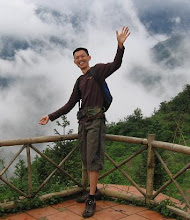
The monks mentioned above are all Thai forest tradition monks, meaning they lead their monastic lives and practice for spiritual development in the forests or wilderness. This means their monasteries are either located in forested areas or if there are no forests nearby, their monasteries will have large areas planted with trees.
The following photos below are from a trip, during Sept 2008, to one such forest tradition monastery, Wat Pateephraram, located in Uttaradit province, north Thailand. See map below.
The abbot is Ajahn Tee Hong (seated extreme left in the photo above), a Taiwanese who is now in his 13th year as a Theravada Buddhist monk. The Genting Buddhist Group was making a return visit to pay respects to several venerable Thai Forest tradition monks of Northern Thailand. After arranging for them the transportation and Thai guide for their previous trip, I decided that this time, besides making the arrangements, I would tag along. While there, we had invited Ajahn Tee Hong to visit us in Malaysia in the near future.
So we are very happy that he finally came together as part of a 7 monk entourage, including Luang Por Kan (seated next to him), whom we also visited in 2008.

PHOTOS BELOW: Wat Pateephraram, Uttaradit, Thailand; circa Sept 2008

Above: The Buddha image hall.

Above: Clean toilet & shower facilities for devotees & visitors

Above: We slept for 2 nights in rooms like this one.

Above and Below: Riverside scenery just outside the monastery. Across the river is the small town of Ban Kaeng.


Above: In the morning, we swept the monastery grounds.

Above: Gathering at the hall for a morning sermon by the monks.
Relaxed & cheerful atmosphere at this monastery's kitchen ....total opposites to Chef Ramsay's "Hell's Kitchen"!!

Above: The Malaysian and local Thai devotees co-operated to complete the cooking. According to precept rules for monks, monks have to take their daily meal before noon.

Above: Food's almost ready. Some of the food have been brought in by local devotees early in the morning.

Above: The Malaysian and local Thai devotees co-operated to complete the cooking. According to precept rules for monks, monks have to take their daily meal before noon.

Above: Food's almost ready. Some of the food have been brought in by local devotees early in the morning.

Above: Monks fill their alms-bowl for their daily meal. Ajahn Tee Hong is in front. Devotees carry the alms-bowl for the monks as a form of respect and to gain merit.

Above: The devotees follow after the monks.

Above: Meanwhile in the hall, the alms-bowl with food is presented to each monk.

Above: The compound of Wat Pateephraram is planted with many trees, typical of a Forest Tradition monastery.

Above: A kuti (monk's dwelling) within the monastery's compound.

Above: A gravel & cement path built for monks to practice walking meditation.

Above: A young novice monk who is from Laos. His parents sent him to Thailand to get a free education at Luang Por Kan's temple, which is also in Uttaradit. It has always been a tradition for Buddhist temples to be places of study for boys from poor families whose parents can't afford to send them to school. While as a novice monk, they follow the 10 precept rules.

Above: A photo with Luang Por Kan (left) and Ajahn Tee Hong (right) before we departed for Chiang Mai.


